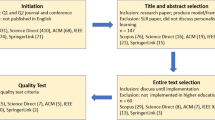Abstract
This article focuses on a Personalised Learning model which has 19 scales that were used to evaluate regional students’ perceptions of their readiness to learn, assessment processes, engagement, extent to which their learning is personalised and their associations with academic efficacy, academic achievement and student well-being. The data came from an average of 2700 students during each year of a 3-year study in six schools in provincial Victoria. A previously reported instrument was developed to measure students’ and teachers’ perceptions of the above factors affecting the implementation of Personalised Learning Plans (PLPs). It employed the latest scales to assess a range of PLP indicator variables, with all scales modified for use in an Australian context and with the total number of items kept to a minimum. Only scales that were more sensitive to PLPs were used in order to minimise the length of the instrument. There were three outcome variables: academic efficacy, academic achievement and student well-being. The emergent model demonstrates that addressing personalisation of learning and well-being depends on a combination of factors rather than “just getting one factor right”. This implies that there is a need for a coherent and collaborative approach for addressing the needs of students of low socioeconomic status.


Similar content being viewed by others
References
Arbuckle, J. L. (2009). Amos 18 user’s guide. Crawfordville, FL: Amos Development Corporation.
Bendigo Education Plan (Loddon Mallee Region). Department of Education and Early Childhood Development. (2005). Melbourne, Australia: DEECD.
Blanchard, J. (2009). Teaching, learning and assessment. Milton Keynes: Open University Press.
Boekaerts, M., & Corno, L. (2005). Self-regulation in the classroom: A perspective on assessment and intervention. Applied Psychology: An International Review, 54(2), 199–231. doi:10.1111/j.1464-0597.2005.00205.x.
Butler, D., & Winne, P. H. (1995). Feedback and self-regulated learning: A theoretical synthesis. Review of Educational Research, 65(3), 245–281. doi:10.3102/00346543065003245.
Campbell, R., Robinson, W., Neelands, J., Hewston, R., & Mazzoli, L. (2007). Personalised learning: Ambiguities in theory and practice. British Journal of Educational Studies, 55(2), 135–154.
Cheung, G. W., & Rensvold, R. B. (2002). Evaluating goodness-of-fit indexes for testing measurement invariance. Structural Equation Modeling: A Multi-disciplinary Journal, 9(2), 233–255. doi:10.1207/S15328007SEM0902_5.
Cutler, T., Waine, B., & Brehony, K. (2007). A new epoch of individualization? Problems with the personalization of public sector services. Public Administration, 85(3), 847–855. doi:10.1111/j.1467-9299.2007.00672.x.
Department for Children, Schools & Families, United Kingdom (DCSF). (2008). Personalised learning: A practical guide. Nottingham: DCSF Publications. http://www.essex.gov.uk/Business-Partners/Partners/Schools/One-to-one-tuition/Documents/Personalised%20Learning%20a%20practical%20guide.pdf.
Department for Education and Skills (DfES). (2004). A national conversation about personalised learning. Nottingham: DfES. https://www.education.gov.uk/publications/eOrderingDownload/DfES%200919%20200MIG186.pdf. Accessed September 11, 2011.
Dewey, J. (1985). Democracy and education, 1916. In J. A. Boydston, & P. Baysinger (Eds.). Carbondale: Southern Illinois University Press.
Drexler, W. (2010). The networked student model for construction of personal learning environments: Balancing teacher control and student autonomy. Australasian Journal of Educational Technology, 26(3), 369–385.
Duckworth, K., Akerman, R., MacGregor, A., Salter, E., & Vorhaus, J. (2009). Self regulated learning: A literature review. (OECD/CERI, 83–100). Paris: OECD.
Dweck, C. S. (2000). Self-theories: Their role in motivation, personality, and development. Philadelphia, PA: Psychology Press.
French, B. F., & Finch, W. H. (2006). Confirmatory factor analytic procedures for the determination of measurement equivalence. Structural Equation Modeling, 13(3), 378–402. doi:10.1207/s15328007sem1303_3.
Hargreaves, D. (2005). Personalising learning 4: Curriculum advice and guidance. London: Specialist Schools Trust.
Leadbetter, C. (2005) The shape of things to come: Personalised learning through collaboration. http://www.innovationunit.org/sites/default/files/The%20shape%20of%20things%20to%20come.pdf. Accessed December 7, 2011.
Mahony, P., & Hextall, I. (2009, September). Building schools for the future and the implications for becoming a teacher. In Paper presented at the European Conference on Educational Research, Vienna.
McLoughlin, C., & Lee, M. (2010). Personalised and self-regulated learning in the Web 2.0 era: International exemplars of innovative pedagogy using social software. Australasian Journal of Educational Technology, 26(1), 28–43. http://www.ascilite.org.au/ajet/ajet26/mcloughlin.pdf.
Meyer, B., Haywood, N., Sachdev, D., & Faraday, S. (2008). Independent learning: Literature review. London: Department for Children, Schools and Families.
Moje, E. B. (2007). Developing socially just subject-matter instruction: A review of the literature on disciplinary literacy. In N. L. Parker (Ed.), Review of research in education (pp. 1–44). Washington, DC: American Educational Research Association.
Paludan, J. (2006). Personalised learning 2025. Schooling for tomorrow: Personalising education (pp. 83–100). Paris: OECD Publishing.
Peirce, C. S. (1931–1958). Collected papers of Charles Sanders Peirce. In C. Hartshorne, & P. Weiss (Eds.), Vols. 1–6; A. W. Burks (Ed.), Vols. 7–8. Cambridge, MA: Harvard University Press.
Pintrich, P. R., & De Groot, E. (1990). Motivated and self-regulated learning components of academic performance. Journal of Educational Psychology, 82, 33–40.
Prain, V., Cox, P., Deed, C., Edwards, D., Farrelly, C., Keefe, M., et al. (2014). Personalising learning: theory and enactment. In V. Prain, P. Cox, C. Deed, D. Edwards, C. Farrelly, M. Keefe, V. Lovejoy, L. Mow, P. Sellings, B. Waldrip, & Z. Yager (Eds.), Adapting to teaching and learning in open-plan schools. Rotterdam: Sense Publishers.
Pykett, J. (2010). Personalised governing through behaviour change and re-education. PSA Conference Paper, Edinburgh.
Sebba, J., Brown, N., Steward, S., Galton, M., & James, M. (2007). An investigation of personalised learning approaches used in schools. London: Department for Education and Skills.
Waldrip, B., Cox, P., Deed, C., Dorman, J., Edwards, D., Farrelly, C., et al. (2014). Student perceptions of personalised learning: Validation and development of questionnaire with regional secondary students. Learning Environments Research, 17(3), 355–370.
Wittgenstein, L. (1972). Lectures and conversations on aesthetics, psychology, and religious belief. Berkeley, CA: University of California Press.
Acknowledgments
The research described in this article was supported in part by an Australian Research Council Linkage Grant LP100200179 called Improving Regional Learning.
Author information
Authors and Affiliations
Corresponding author
Rights and permissions
About this article
Cite this article
Waldrip, B., Yu, J.J. & Prain, V. Validation of a model of personalised learning. Learning Environ Res 19, 169–180 (2016). https://doi.org/10.1007/s10984-016-9204-y
Received:
Accepted:
Published:
Issue Date:
DOI: https://doi.org/10.1007/s10984-016-9204-y




